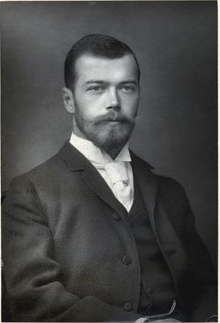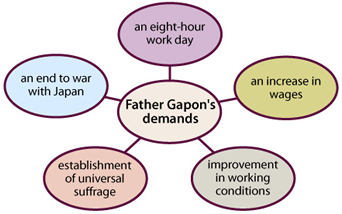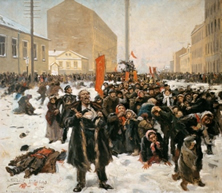Lesson Two: The Russian Revolution
2. Lesson 4.2.1 Tsarist Rule in Russia
Tsarist Rule in Russia
Tsar Nicholas II
Before 1917, Russia had been under the rule of absolute monarchs. The tsars*, the kings and queens of Russia, had ruled the country for hundreds of years with little concern for the needs of the citizens
of their country. The last Russian tsar, Nicholas II, could no longer fight the forces of nationalism and liberalism in his country. Political and economic change in Russia was inevitable.
*tsar is
sometimes also "czar".
Under the tsars, Russian society was divided into social and economic classes. Peasants worked the land (oppressed despite the abolition of serfdom), the Kulaks were wealthy farmers of the Ukraine, and the workers were in the growing industries of Russia.
Nicholas II had introduced some forms of liberalism to his absolute form of government. Liberal ideas had spread through Europe, and Russians were demanding similar changes. Nicholas II allowed for an elected Duma, which was a representative assembly. Although the Duma was an elected form of government, the tsar still had ultimate power and could disregard any decisions made by the Duma. Russians were angered that the tsar would not listen to their demands for more food, better working conditions, and better government.
Under the tsarist regime of Nicholas II, industry and farming were controlled mainly by royalty. For the vast majority of Russian citizens, life was difficult because they worked for wealthy landowners or factory owners who paid them very small salaries. As in Europe, these workers laboured long hours in unhealthy factories with very little chance of increased pay or improved working conditions. Very few peasant farmers owned land.
Nicholas II, the last tsar of Russia, was a weak tsar who ruled Russia in difficult times. Many factors led to the end of his rule:
-
Most of the Russian people had poor living and working conditions.
-
The spread of liberal ideas throughout Europe incited the Russian people toward change.
-
Nicholas' was a weak leader unable to listen to the Russian people.
-
Events such as Bloody Sunday showed his weak rule.
-
Nicholas' poor conduct of the Russian army during World War I resulted in huge death tolls and famine (starvation) causing rebellion among the Russian soldiers and people.
-
Nicholas' son's illness (hemophilia — a potentially fatal blood disorder) distracted the tsar from his duties.
-
Nicholas refused to share power with the Russian parliament, or Duma.
Bloody Sunday, 1905
In the late 19th and early 20th centuries, Russian industrial employees worked an average of eleven hours per day, six days a week. Conditions in the factories were extremely harsh, and the factory owners showed little concern for workers' health and safety. The workers attempted to form unions to help improve conditions, but the factory owners and the tsars resisted these attempts by the workers. In 1903, Father George Gapon formed the Assembly of Russian Workers, a union that promoted workers' rights.
1904 had been a bad year for Nicholas II's Russia. The war with Japan had gone very badly. Two Russian fleets had been destroyed, and a Russian army had been forced to surrender its only Pacific port at Vladivostok.
In addition, the year 1904 had been a bad one for Russian workers. Prices of basic goods and services had risen quickly, and wages declined by 20 per cent. When four members of the Assembly of Russian Workers were fired from an iron works factory, Father Gapon decided to take action. Under his leadership, more than 110 000 workers in St. Petersburg went on strike.
In an attempt to settle the dispute, Father Gapon decided to make a personal appeal to Nicholas II. He wrote a petition outlining the workers demands.

Tsar Nicholas II

Father Gapon

Bloody Sunday, 1905


More than 150 000 people signed the petition. On January 22, 1905, Father Gapon led the unarmed demonstrators (workers) to the Winter Palace in St. Petersburg to present the petition to Tsar Nicholas II. Nicholas was not at the Winter Palace, and the guards did not know how to react to the demonstrators. In panic, the guards shot in the air. The demonstrators continued to advance and the soldier's panic grew. In desperation, the soldiers fired on the advancing crowd. More than 100 workers were killed, and 300 workers were wounded. This incident is known as Bloody Sunday because of the blood on the snow after the attack. It has been said that even if the tsar had been at the Winter Palace, he would not have listened to Father Gapon's demands anyway.
Bloody Sunday is known as the first step to the Russian Revolution of 1917. The hardships and inequalities that people experienced during this time and the spread of liberal values led to the uprising of the workers. Events such as Bloody Sunday were dramatic proof of the desire for social, political, and economic change.